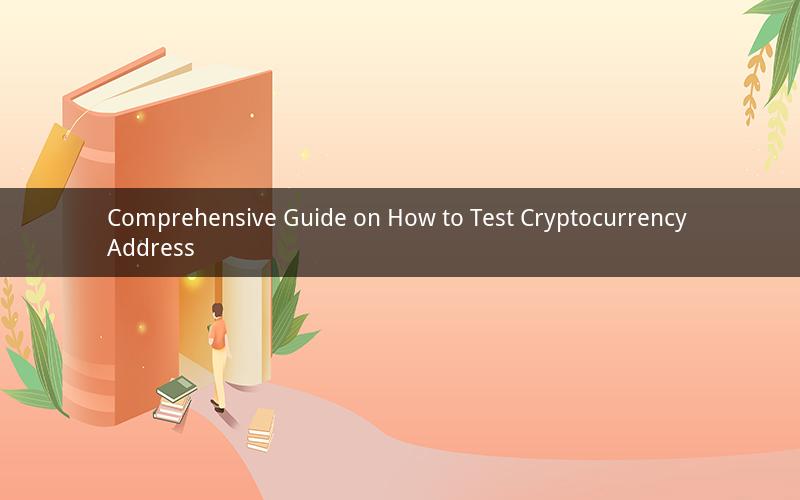
Introduction:
In the world of cryptocurrencies, the address plays a crucial role in facilitating transactions. However, it is essential to ensure the validity and security of the address before engaging in any financial activity. This article aims to provide a detailed guide on how to test a cryptocurrency address, covering various methods and tools available to users.
1. Understanding Cryptocurrency Address:
Before diving into the testing process, it is essential to understand what a cryptocurrency address is. An address is a unique identifier that allows users to send, receive, and store cryptocurrencies. It is typically a string of alphanumeric characters and can be represented in different formats depending on the blockchain network.
2. Methods to Test Cryptocurrency Address:
a. Manual Verification:
One of the simplest methods to test a cryptocurrency address is by manually verifying its format. Here are some key points to consider:
- Length: Most cryptocurrency addresses have a specific length, usually between 26 to 35 characters. Ensure that the address adheres to this length requirement.
- Alphanumeric Characters: Addresses consist of alphanumeric characters, including letters (both uppercase and lowercase) and numbers. Check if the address contains only these characters.
- Starting Character: Certain cryptocurrencies have specific starting characters for their addresses. For example, Bitcoin addresses typically start with '1' or '3', while Ethereum addresses start with '0x' followed by alphanumeric characters.
b. Blockchain Explorer:
Blockchain explorers are online tools that allow users to view and verify transactions on a specific blockchain network. Here's how to use a blockchain explorer to test a cryptocurrency address:
- Visit a reputable blockchain explorer for the respective cryptocurrency (e.g., Blockchain.com for Bitcoin, Etherscan for Ethereum).
- Enter the address in the search bar and hit enter.
- If the address is valid, the explorer will display the transaction history, including the sender, receiver, amount, and timestamp. If the address is invalid, the explorer will not display any information.
c. Cryptocurrency Wallet:
Another method to test a cryptocurrency address is by using a wallet that supports the respective cryptocurrency. Here's how to do it:
- Open your cryptocurrency wallet.
- Click on the "Receive" or "Receive Funds" option.
- Copy the displayed address.
- Paste the address in the wallet and click "Verify" or "Check Address."
- The wallet will validate the address and display the balance or transaction history associated with it.
3. Best Practices for Testing Cryptocurrency Address:
a. Double-Check the Address:
Always double-check the address for any typos or errors. A single character mistake can result in losing your funds permanently.
b. Use Reliable Tools:
When using online tools or blockchain explorers, ensure that they are reputable and have a good track record. This will help you avoid potential scams or malware.
c. Be Wary of Phishing Attempts:
Scammers often create fake addresses or websites to steal your funds. Be cautious and verify the legitimacy of any address or website before interacting with it.
4. Frequently Asked Questions (FAQs):
Q1: Can I test a cryptocurrency address without using any tools?
A1: Yes, you can manually verify the address format, but it may be time-consuming and less accurate compared to using specialized tools or blockchain explorers.
Q2: What happens if I send funds to an invalid address?
A2: If you send funds to an invalid address, the transaction will fail, and your funds will be locked. It is crucial to verify the address thoroughly before initiating any transactions.
Q3: Can I test the validity of a cryptocurrency address on any blockchain network?
A3: No, different cryptocurrencies operate on different blockchain networks. Ensure that you use the appropriate blockchain explorer or wallet for the specific cryptocurrency you are testing.
Q4: Are there any limitations to testing a cryptocurrency address?
A4: The limitations depend on the tools or methods you use. For instance, manual verification may be time-consuming, while blockchain explorers or wallets may have limitations in terms of address validation or transaction history retrieval.
Q5: Can I test a cryptocurrency address on a mobile device?
A5: Yes, many blockchain explorers and wallets offer mobile applications, allowing you to test cryptocurrency addresses on your smartphone or tablet.
Conclusion:
Testing a cryptocurrency address is a crucial step in ensuring the security and validity of your transactions. By understanding the different methods and tools available, you can confidently verify cryptocurrency addresses and protect your funds from potential risks. Always remember to double-check the address, use reliable tools, and stay vigilant against scams.